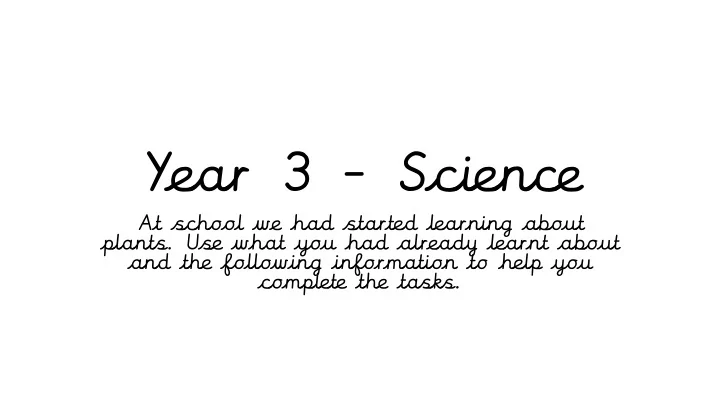

Year 3 - Science At school we had started learning about plants. Use what you had already learnt about and the following information to help you complete the tasks.
Task 1 – Parts of a flower
Can you remember the parts of the plant?
Can you remember the parts of the plant?
Next, we will focus more closely at the flower of the plant. What do you think?... What is the flower? What does it do? Why do plants have them?
The flower’s job is to create seeds so that new plants can be grown. Flowers are made up of lots of parts that work together to make seeds.
Task 1 – Flower Dissection See worksheet for instructions
Task 2 – What jobs do they do? How do you think the different parts of the plant help the plant to make new seeds?
Use the diagram to help you. What is a petals job?
Use the diagram to help you. What is a filaments job?
Use the diagram to help you. What does the stigma do?
Task 2 – Use the diagram on the slides to create a poster explaining what the parts of the flowers do. If you want to do some extra research of your own, this is okay.
Task 3 – Pollination and Fertilisation What could these words mean?
Pollination and Fertilisation Pollination occurs when pollen from the anther is transferred to the stigma. Wind can blow pollen from one plant to another. Insects like bees and butterflies are attracted to the bright colours of the petals and the sweet scent of the flower. They visit the flower to drink a sweet liquid called nectar.
Pollination and Fertilisation When an insect goes into the flower to drink the nectar, some grains of pollen brush off the anthers onto their body. When the insect visits another flower for more nectar, the grains of pollen transfer from the insect's body to the sticky stigma of the new flower. This is pollination.
Pollination and Fertilisation The pollen on the stigma then travels down the style towards the ovary. Stigma Style
Pollination and Fertilisation Once it reaches the ovary, the pollen joins with an ovule. The ovule can then grow into a seed. This is known as fertilisation. Below are some pictures of seeds Poppy Pea seeds seeds grow grow inside inside the the enlarged ovary, ovary. or the pea pod.
Summary… see task 3 1. Pollinat inatio ion is when pollen from the anther is transferred to the stigma. This can happen in different ways. Wind nd – the wind can blow pollen from one plant to an- other. Pollinat inators rs – insects such as bees, butterflies and flies are attracted to the brightly coloured petals. 2. They land on a flower to drink nectar. 3. When they land, grains of pollen stick to them. 4. Then, when they go to the next flower, the pollen is transferred. 5. Once the pollen is transferred to the stigma, it travels down the style to the ovary. 6. This is where the seed grows.
Task 4 Using your learning you need to design a brand new flower! (see worksheets)
Recommend
More recommend